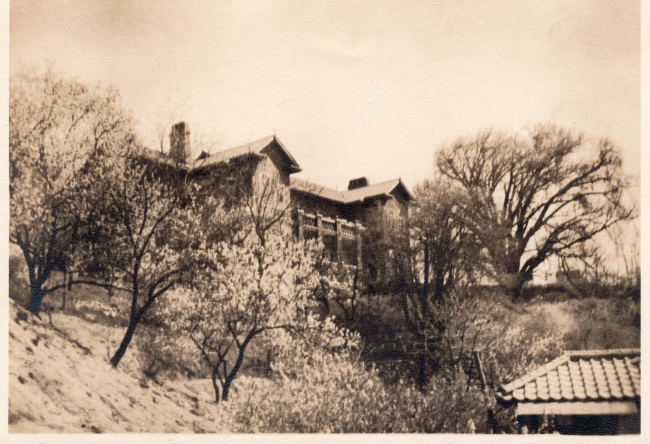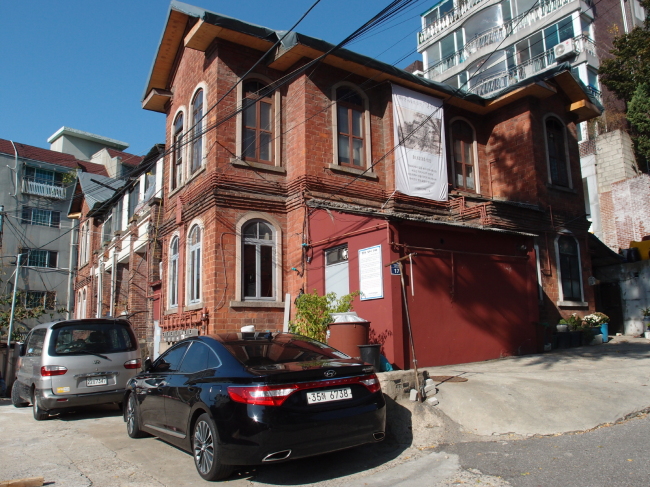City moves to restore Dil Kusha residence in Seoul
Home of AP correspondent Albert Taylor to be restored and turned into a museum
By KH디지털2Published : March 2, 2016 - 15:16
For many years, Dil Kusha was a mystery.
It sits quietly yet conspicuously near Sajik Tunnel in Jongno-gu, Seoul, a red brick two-story house that blends English and American architectural styles. Everyone knew it was there, but no one knew where it came from or who owned it. When squatters took over, it fell into a dilapidated state.
It was not until 2006 that the history of the house was unveiled by an American named Bruce Taylor. On a visit to Korea, he revealed that the Dil Kusha was his childhood home built in 1923 by his father, the late AP correspondent Albert Taylor.
The name “Dil Kusha,” given by Albert’s wife Mary, was inspired by a house called “Dilkusha Kothi” in Lucknow, India, whose name translates to “Palace of Heart’s Delight.”
It sits quietly yet conspicuously near Sajik Tunnel in Jongno-gu, Seoul, a red brick two-story house that blends English and American architectural styles. Everyone knew it was there, but no one knew where it came from or who owned it. When squatters took over, it fell into a dilapidated state.
It was not until 2006 that the history of the house was unveiled by an American named Bruce Taylor. On a visit to Korea, he revealed that the Dil Kusha was his childhood home built in 1923 by his father, the late AP correspondent Albert Taylor.
The name “Dil Kusha,” given by Albert’s wife Mary, was inspired by a house called “Dilkusha Kothi” in Lucknow, India, whose name translates to “Palace of Heart’s Delight.”

Albert had reported on the realities of life in Korea under Japanese colonial rule and the peaceful opposition movements by Koreans, most notably the March 1 Independence Movement.
Albert came across a copy of the Declaration of Independence that had been hidden under a hospital bed at Severance Hospital, where his son Bruce was born on Feb. 28, 1919. He smuggled it out of the country through his brother Bill, and was hired by the Associated Press as a special correspondent. He was the only Western journalist to live in Korea while covering Korea’s movements for independence from Japanese rule.
The Taylors lived in Dil Kusha for roughly 20 years, before the Japanese authorities forced Albert to leave the country in 1942.
Following the Taylor family’s departure, the building was owned briefly by former lawmaker Cho Kyung-kyu before it was seized by the government along with the rest of his property in 1963 after Cho’s assets were deemed to have been unjustly obtained.

Dil Kusha’s value both in terms of architectural and cultural history moved the Seoul Metropolitan Government to take action in restoring and preserving it for the future.
On Feb. 26, the Seoul Metropolitan Government announced that it would be coordinating with the district office of Jongno-gu, the Cultural Heritage Administration and the Ministry of Strategy and Finance to restore and manage the building. The city’s goal is to have it restored to its original form and ready for a pubic opening by 2019, the 100th anniversary of the March 1 Independence Movement.
The multi-branch coordination is meant to facilitate the logistical difficulties of transforming Dil Kusha into a monument. The first necessary step is to vacate the building of its 23 squatters, who are living in 12 arbitrarily divided spaces. Moving the squatters will require special attention as many of them are destitute or disabled. The agreement called for “consideration within the bounds of the law and existing institutions” when vacating the house.

According to the Seoul Metropolitan Government, the difficulty of safely evacuating and relocating the squatters has been a barrier to designating the house as a monument with the Cultural Heritage Administration.
Once the building is restored, Dil Kusha will become a museum displaying items used by the Taylor family during their residence. It will also feature various visual materials introducing the life of Albert Taylor and his reporting during Japan’s colonial rule over Korea.
Some of those materials will come from a collection donated by Albert Taylor’s granddaughter Jennifer Taylor, who visited the Seoul Museum of History on March 2 with 349 items including sketches, newspaper clippings, and photographs.
By Won Ho-jung (hjwon@heraldcorp.com)









![[Robert J. Fouser] Social attitudes toward language proficiency](http://res.heraldm.com/phpwas/restmb_idxmake.php?idx=644&simg=/content/image/2024/05/16/20240516050799_0.jpg&u=)
![[Graphic News] How much do Korean adults read?](http://res.heraldm.com/phpwas/restmb_idxmake.php?idx=644&simg=/content/image/2024/05/16/20240516050803_0.gif&u=)






![[Herald Interview] Byun Yo-han's 'unlikable' character is result of calculated acting](http://res.heraldm.com/phpwas/restmb_idxmake.php?idx=652&simg=/content/image/2024/05/16/20240516050855_0.jpg&u=)
